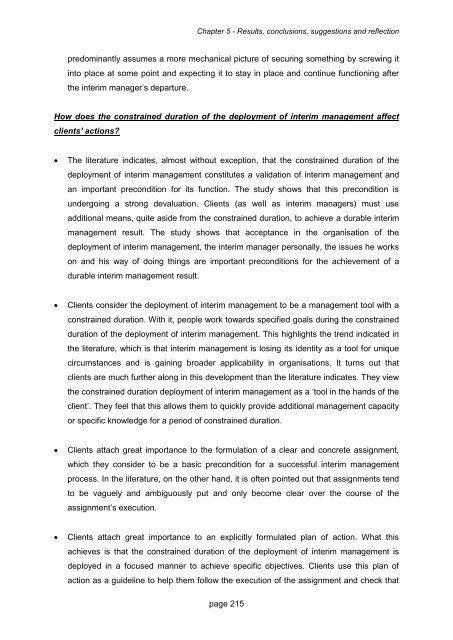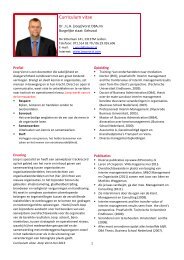Hoofdstuk 1 - Joop Vorst
Hoofdstuk 1 - Joop Vorst
Hoofdstuk 1 - Joop Vorst
You also want an ePaper? Increase the reach of your titles
YUMPU automatically turns print PDFs into web optimized ePapers that Google loves.
Chapter 5 - Results, conclusions, suggestions and reflection<br />
predominantly assumes a more mechanical picture of securing something by screwing it<br />
into place at some point and expecting it to stay in place and continue functioning after<br />
the interim manager‟s departure.<br />
How does the constrained duration of the deployment of interim management affect<br />
clients' actions?<br />
The literature indicates, almost without exception, that the constrained duration of the<br />
deployment of interim management constitutes a validation of interim management and<br />
an important precondition for its function. The study shows that this precondition is<br />
undergoing a strong devaluation. Clients (as well as interim managers) must use<br />
additional means, quite aside from the constrained duration, to achieve a durable interim<br />
management result. The study shows that acceptance in the organisation of the<br />
deployment of interim management, the interim manager personally, the issues he works<br />
on and his way of doing things are important preconditions for the achievement of a<br />
durable interim management result.<br />
Clients consider the deployment of interim management to be a management tool with a<br />
constrained duration. With it, people work towards specified goals during the constrained<br />
duration of the deployment of interim management. This highlights the trend indicated in<br />
the literature, which is that interim management is losing its identity as a tool for unique<br />
circumstances and is gaining broader applicability in organisations. It turns out that<br />
clients are much further along in this development than the literature indicates. They view<br />
the constrained duration deployment of interim management as a „tool in the hands of the<br />
client‟. They feel that this allows them to quickly provide additional management capacity<br />
or specific knowledge for a period of constrained duration.<br />
Clients attach great importance to the formulation of a clear and concrete assignment,<br />
which they consider to be a basic precondition for a successful interim management<br />
process. In the literature, on the other hand, it is often pointed out that assignments tend<br />
to be vaguely and ambiguously put and only become clear over the course of the<br />
assignment‟s execution.<br />
Clients attach great importance to an explicitly formulated plan of action. What this<br />
achieves is that the constrained duration of the deployment of interim management is<br />
deployed in a focused manner to achieve specific objectives. Clients use this plan of<br />
action as a guideline to help them follow the execution of the assignment and check that<br />
page 215



